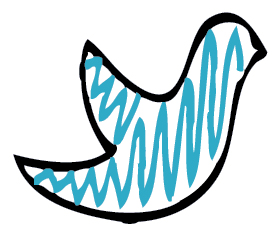Chapter 2
‘Less’ Is the New ‘More’
“Would you have been so brief with him, he would have been so brief with you; to shorten you.”
King Richard II

When I was first asked to comment on how much Twitter has contributed to the rise of the personal brand, a particular quote immediately sprang to mind; a quote usually attributed to Mark Twain, although actually written by Blaise Pascal: “I would have written a shorter letter, but I did not have the time.”
It’s a profound and an oh so true statement about how Twitter has been able to boil down content to its true core message — and the same is true for your brand and its core message.
Sorting the Wheat from the Chaff
These days, information is fast-flowing and constant, and it has become increasingly hard to sort the wheat from the chaff in terms of what adds value to both my businesses and myself. I find lengthy articles best saved for those bedtime reading moments that increasingly never seem to come, as all too often I fall into bed in the wee small hours, when reading is the furthest thing from my exhausted mind.
It is a scientifically proven fact that how we read content has changed due to the evolution of how information reaches us and the speed with which it does so. And the change isn’t a recent one. As far back as 1997, Jakob Nielsen of Alertbox was researching the way that people read web pages. What he discovered is that, in fact, we don’t! Instead we scan, picking out individual words and sentences. In Nielsen’s research, he discovered that 79 percent of his test readers always scanned new pages and only 16 percent read word by word. Nielsen continued his studies and, in 2010, found that this figure had increased to 83 percent, and even further to 85 percent when information was received via mobile devices.
As a result, web pages had to use “scannable” text, using:
- highlighted keywords (hypertext links serve as a form of highlighting; typeface variations and color are other methods)
- meaningful subheadings (not “clever” ones)
- bulleted lists
- one idea per paragraph (users skip over any additional ideas if they are not caught by the first few words in the paragraph)
- inverted pyramid style, starting with the conclusion
- half (or less) the word count than conventional writing
When you incorporate reader style into the content you build, you begin to see how Twitter is a great ally to your brand in ensuring you master the art of succinct and disciplined content.
In my postgrad student years, when I first started promoting my one-act plays to drama societies, I remember attending a lecture given by the eminent playwright Alyn Aykborn at the University of Wales in Cardiff, South Wales. I sat in awe as he talked about his approach to scene dialog and, again, the virtues of the “less is more” philosophy to writing. He said that he never added to his work but, instead, subtracted, to apply more meaning and resonance to his plays. He reminded the class that it’s not what you put in but what you can take out that provides the most power for the audience. Looking back at the lecture, he could very well have been talking about writing for Twitter.
The World in Our Pockets
And then there’s the mobile element. The way society increasingly chooses to receive its content on the move is driven by our incessant need for speed and the concept that there are just never enough hours in the day. These are major contributing factors to Twitter’s phenomenal success and the reason that its power continues to grow. We need our world to be portable; one that we can carry in our pockets. It’s up to the brands themselves to communicate in a way that resonates most with their audience by clever curation and tweet construction.
My husband, Dr. Dean Anthony Gratton, coined the term “the Lawnmower Man Effect” (see Figure 2-1) to explain this very shift in his book The Handbook of Personal Area Networking Technologies and Protocols (Cambridge University Press, 2012).
He wrote, “The Lawnmower Man Effect (LME) represents the consumers’ ability to traverse digital systems across the globe all captained from their personal area networking space utilizing pervasive WAN technologies.”
Figure 2-1
A graphic representation of the Lawnmower Man Effect (courtesy of Cambridge University Press)

The term is used to describe the need we have to be “intrinsically connected” to our world through technology. It came about as a result of our weekly Friday movie-night ritual, where one of us each week chooses a different (and sometimes obscure) movie from their childhood to watch over a chili and taco supper. We had tuned into my choice of the 1980s movie The Lawnmower Man this particular Friday; where the brilliant scientist, played by Pierce Brosnan, subjects the imbecile gardener, played by Jeff Farley, to a series of experiments that transform him from blithering idiot to mind-blowing genius in a matter of weeks. The movie takes a malevolent turn however, as all good Friday-night movies do, when our newly created Einstein turns into a fiendishly knowledge hungry monster and eventually evolves to become a malignant part of the technology itself.
I was happily crunching my taco to the sound of Brosnan’s screams when the whoop of joy beside me indicated that hubby had experienced another of his “Eureka!” moments in finding the perfect example on which to coin his latest theory.
Journalism has been forced to wake up and respond to these changes. Some writers have embraced them, while others have rejected their appeal, hoping against hope that the platform will die and society will return to, what they consider to be its former glory days.
An associate editor at Poynter.org, Mallary Jean Tenore, has found Twitter to be a great asset to her writing (see Figure 2-2). She explains, “Twitter taught me that, in writing, every word counts (literally). By limiting myself to 140 characters, I have to be strategic about how many words I use and how I use them. Training myself to write succinctly on Twitter has made me more aware of extra words in my stories.
“I’ve cut down the clutter, but still tend to be wordy when I’m unsure of what I want to say, or when I’m tired and preoccupied. I recently started a new experiment to help with this. As time allows, I read through my stories before submitting them and read every sentence as if it were a tweet. How would I write this sentence if I were tweeting it? Are there words I could cut that would save space but not change the meaning of what I’m saying? If so, I start trimming.”
Figure 2-2
Writer Mallary Jean Tenore has found Twitter to be an asset to her writing style.

Spring-Cleaning Your Brand Approach
One of Twitter’s greatest gifts to brands lies in its simplicity. It enables us to cut through the clutter and fine-tune our content, along with the way that we share it with our audience, by focusing on what really matters to us and to them. Gone are the sugarcoating and marshmallow padding of those corporate promotions of old. It’s time to revamp brand “us” and clean up our online act so that every Twitter message not only reflects us, but the value that our brand can offer to others.
Once you’ve learned how to maximize your brand dialog by minimizing its content, you can use the architecture of the perfect Twitter formula that I explain in Chapter 5. It’s a unique method that brings together all the essential elements you need to create a sustainable brand impact each and every day regardless of location, and it’s one that works for your brand around the clock to ensure that your tweets keep your audience retweeting and coming back for more.
In Chapters 3 through 10, you learn how to adopt literally thousands of brand ambassadors; those loyal followers who work to promote brand “you” every day.
I lead you through everything you need to know to translate your personal statement onto Twitter and to nurture it through cross-platform promotion, landing page primers, and other never-before-revealed secrets to success.
I also show you how to translate your brand message globally across a variety of different cultures and philosophies; something that’s vital for worldwide success.
So read on and let’s get building brand “you.”

